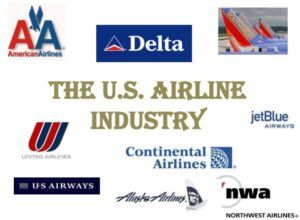- The introduction of deregulation in the previous years has resulted in reduced profitability in the US airline industry. For instance, in the 1980s and 1990s, the return on investment in the sector averaged 6.8% and 5.1% respectively. Restitution on investment depressed significantly to 2.1% in 2006. The performance of the industry in 2006 was profitable. However, it earned negative economic returns. The poor performance of the sector is attributed to high cost of fuel. The US airline experiences intense competition. The high cost of oil is directly passed to the consumers. When the cost of fuel rises, the fares are increased to increase the profit margin. The depressing profitability in the industry can be discussed using Porters five forces.
- The industry enjoys duopoly and monopoly power in the market. The employee unions have utilized the monopoly power to raise and keep the benefits and wages high. Besides, the pilots union has employed restrictive industrial practices which have resulted in low productivity. The suppliers (airplane manufacturers) enjoy duopoly. As such, supplier power depends on the forces of demand and supply. The bargaining power of the airlines is influenced by the capacity of the manufacturers. For instance, excess capacity may prompt the airlines to delay buying.
- Contestability is the primary reason for deregulation in the industry. The airlines cannot establish their own routes. Besides entering a new regional market is not easy. As such, the return on investment in the industry cannot match a perfect competition market. It is hard to put together the resources required to establish and operate an airline. The proprietor is required to assemble crews, pilots, landing slots and gates. This is very expensive and bars several individuals from entering the industry. High competition from recognized airlines also prohibits new entrants.
- There is an aggressive competition between the established airlines in the industry. The primary competitive force has been driven by varying structural factors. Most airline companies have based their competition on price. The airlines are willing to give out their empty seats at a price that will cover the variable costs. The prices are to ensure that the overhead receives significant contribution. However, the firms cannot lower their prices below the average cost since that will result in significant loss.
- Online sales have enhanced transparency in ticketing. Most customers can access the prices on the internet. The increased number of people using airlines has made it possible for various companies to seek lucrative deals with established airlines. The online travel agencies have consolidated airline business. As such, the fares have significantly reduced. Most airline firms have also cut cost to increase their profit margin. For instance, some of the airline companies do not encourage their staffs to utilize business class and first class to enhance return on investment.
- The current situation is attributed to growing demand that surpasses capacity. However, the industry can consider favorable factors to increase profitability. The industry should balance its capacity and demand. The growth in demand and capacity should be proportional to enhance profitability. Mergers and acquisition will also enable the company to realize profits. Airlines consolidation will help the industry to reduce cost and improve profitability. The major airlines should also reduce overhead costs and reduce competitive advantage to allow more airlines in the industry.
- It is assumed that the industry profits realized in the industry will decline in the long-run. However, the capacity of the established airline firms will remain the same because of the existing barriers to entry.
